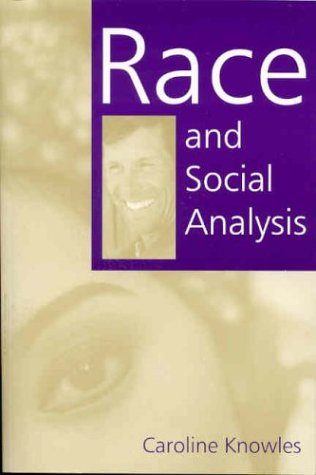Race and Social Analysis
Knowles, Caroline
Sage Publications, London
2004
0761961267
 Race and Social Analysis is a clear and strongly argued account of the processes of ‘race’ and ethnicity, and how each is integral to self, society and belonging. “This book is an attempt to nudge [race] into the mainstream; to insist that race is a central, not peripheral, part of the way things work” (p.11). The book is based in Knowles’s autobiographical reflections on her whiteness – “a reckoning with forms of social injustice and brutality organised by race and ethnicity” (p.xi) – and begins with the view from her window in Southampton, ranging outwards to a city where people arriving and leaving has always been commonplace for sailors, travellers and, more recently, asylum seekers.
Race and Social Analysis is a clear and strongly argued account of the processes of ‘race’ and ethnicity, and how each is integral to self, society and belonging. “This book is an attempt to nudge [race] into the mainstream; to insist that race is a central, not peripheral, part of the way things work” (p.11). The book is based in Knowles’s autobiographical reflections on her whiteness – “a reckoning with forms of social injustice and brutality organised by race and ethnicity” (p.xi) – and begins with the view from her window in Southampton, ranging outwards to a city where people arriving and leaving has always been commonplace for sailors, travellers and, more recently, asylum seekers.
The book is divided into eight chapters: (1) Introduction; (2) People and Race Making; (3) Lives and Auto/Biography; (4) The Place of Space; (5) Globalisation; (6) Migration, Displacement and Belonging; (7) The Unbearable Whiteness of Being; and (8) Concluding Comments. Each chapter provides a mini contents list at the beginning and clear summary at the end.
Knowles argues that “race is neither an illusion nor a biological fact. It has a salience and a social reality in everyday lives” and despite its crucial importance to the organisation of things is often overlooked – for example, very little academic research is approached through the prism of race (p.10). Knowles argues that we must begin to examine the small, everyday aspects of the structures of race. “The contributions of people in the making, organisation and routine maintenance of racialised regimes is systematically occluded by the conceptualisation of race as primarily a big picture problem” (p.27). It is this that makes this book so much more readable than other similar accounts. Knowles provides case studies to illustrate her arguments, using specific experiences or events, tying the big picture to the micro. For example, a case study of Oprah Winfrey (pp.70 – 72) illuminates the premise that ‘race’ is about people’s lives. But Knowles also provides macro case studies about people and space and how race is ‘made’ across contexts and continents. She addresses the issues of globalisation and migration, examining the history of Diasporas and ideas about ‘home’, but also other, more modern, sorts of migration (such as ‘lifestyle migration’).
The final chapter addresses whiteness and how being white is seen as the ‘norm’ with other races and ethnicities problematised. Knowles adopts a critical stance on whiteness and provides a historical account of the mechanisms and boundaries of whiteness – including how the British Empire shaped modern whiteness. She argues that “racial imagery is central to the organisation of the modern world, and its regimes in which whites are privileged” (p.175) and examines the everyday experiences of being white.
The main themes running throughout the book are race, globalisation, displacement and belonging, and the history of people and places. Knowles writes eloquently about how we can challenge and change racist ideas, and ideas about race. As she says, “race is all around us. Race is mundane” (p.10). Thus 'race' applies to all people in all places. This is an important and enjoyable book, which would be valuable to academics or students of any discipline – if you are a person in a place you should read this book.
Samantha Holland
Leeds Metropolitan University

